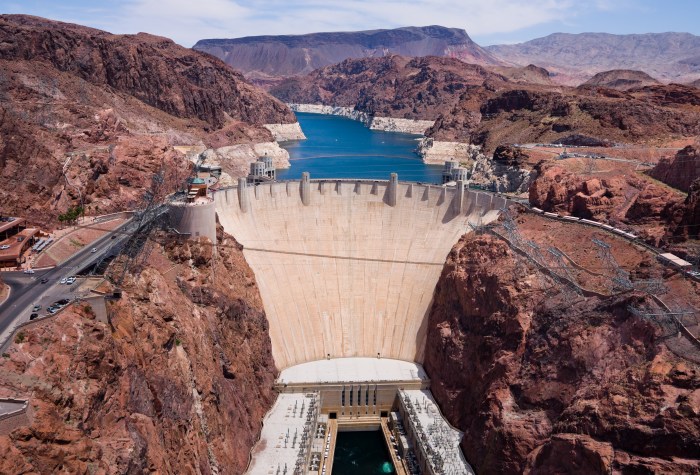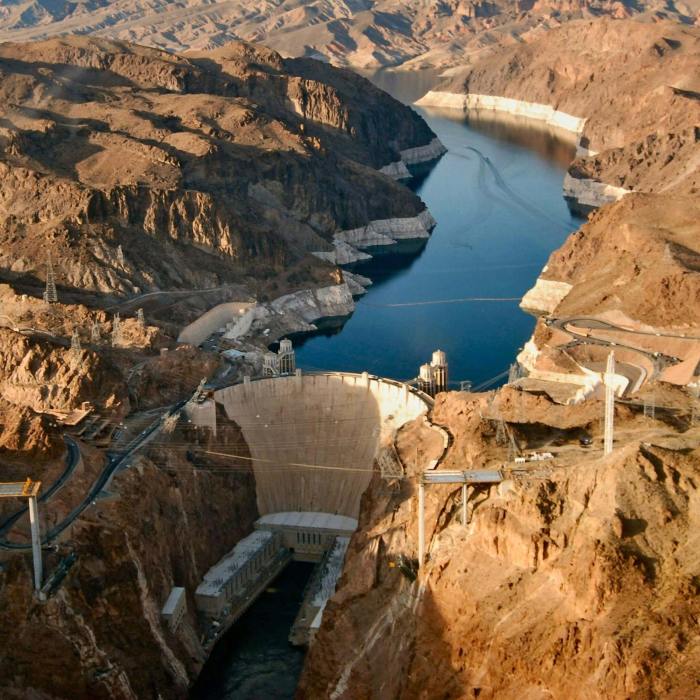The hoover dam backs up the colorado river – The Hoover Dam, a colossal engineering marvel, stands as a testament to human ingenuity, forever altering the course of the Colorado River. Its construction, spanning decades, has left an indelible mark on the landscape, transforming a rugged canyon into a vast reservoir, Lake Mead.
The dam’s impact extends far beyond its physical presence, shaping the economic, social, and ecological dynamics of the surrounding region.
This comprehensive exploration delves into the multifaceted story of the Hoover Dam, examining its genesis, construction challenges, and profound implications. We will unravel the intricate web of engineering innovations that brought this colossal structure to life, while also assessing its ecological consequences and the ongoing challenges it faces in the face of climate change and water scarcity.
Overview of the Hoover Dam and Its Role in the Colorado River System

The Hoover Dam is an iconic concrete arch-gravity dam in the Black Canyon of the Colorado River on the border between the U.S. states of Nevada and Arizona. It was constructed between 1931 and 1936 during the Great Depression and was dedicated on September 30, 1935, by President Franklin D.
Roosevelt.
Purpose and History, The hoover dam backs up the colorado river
The Hoover Dam was built primarily to control flooding, provide irrigation water for agriculture, and generate hydroelectric power. The dam’s construction was a major undertaking that required the diversion of the Colorado River and the excavation of millions of cubic yards of rock.
The dam is 726 feet (221 meters) high and 1,244 feet (379 meters) long at its crest. It contains 3.25 million cubic yards (2.5 million cubic meters) of concrete and has a capacity of 32.3 million acre-feet (40 billion cubic meters) of water.
Impact on the Colorado River
The Hoover Dam has had a significant impact on the Colorado River. The dam has created Lake Mead, the largest reservoir in the United States, which provides water for millions of people in the southwestern United States. The dam has also helped to control flooding and provide a reliable source of hydroelectric power.
However, the dam has also had some negative impacts on the river’s ecosystem, including the loss of habitat for native fish species.
Formation of Lake Mead Behind the Hoover Dam

The construction of the Hoover Dam led to the creation of Lake Mead, the largest reservoir in the United States. Lake Mead is located behind the dam in the Black Canyon of the Colorado River. The lake has a surface area of 248 square miles (642 square kilometers) and a capacity of 32.3 million acre-feet (40 billion cubic meters) of water.
Size, Depth, and Capacity
Lake Mead is 110 miles (177 kilometers) long and has a maximum depth of 530 feet (162 meters). The lake’s average depth is 132 feet (40 meters). Lake Mead is the largest reservoir in the United States by volume and the fourth largest reservoir in the world.
Role in Water Storage, Flood Control, and Recreation
Lake Mead provides water for millions of people in the southwestern United States. The lake also helps to control flooding and provides a reliable source of hydroelectric power. Lake Mead is a popular recreation destination, with activities such as boating, fishing, and swimming.
Impacts on the Colorado River’s Flow and Ecology

The Hoover Dam has had a significant impact on the flow rate and patterns of the Colorado River. The dam has reduced the river’s flow rate by about 90%. The dam has also changed the river’s temperature and sediment transport patterns.
Impact on the River’s Ecosystem
The changes in the Colorado River’s flow rate and patterns have had a negative impact on the river’s ecosystem. The loss of habitat has led to a decline in native fish populations. The dam has also blocked the migration of fish, which has further reduced their populations.
Role in Managing Water Resources
Despite its negative impacts on the Colorado River’s ecosystem, the Hoover Dam plays a vital role in managing water resources for downstream users. The dam provides a reliable source of water for millions of people in the southwestern United States.
The dam also helps to control flooding and provides a source of hydroelectric power.
FAQ Compilation: The Hoover Dam Backs Up The Colorado River
What is the primary purpose of the Hoover Dam?
The Hoover Dam serves multiple purposes, including water storage, flood control, hydroelectric power generation, and recreation.
How large is Lake Mead?
Lake Mead, formed behind the Hoover Dam, is the largest reservoir in the United States, with a surface area of over 247 square miles and a capacity of approximately 26.3 million acre-feet.
What are some of the environmental impacts associated with the Hoover Dam?
The construction of the Hoover Dam has had significant ecological consequences, including the disruption of fish migration patterns, the alteration of riparian habitats, and the introduction of invasive species.
How is the Hoover Dam addressing the challenges of climate change?
The Hoover Dam is actively implementing strategies to adapt to climate change, such as optimizing water releases to balance power generation and water conservation, and exploring renewable energy sources to supplement hydroelectric power.
